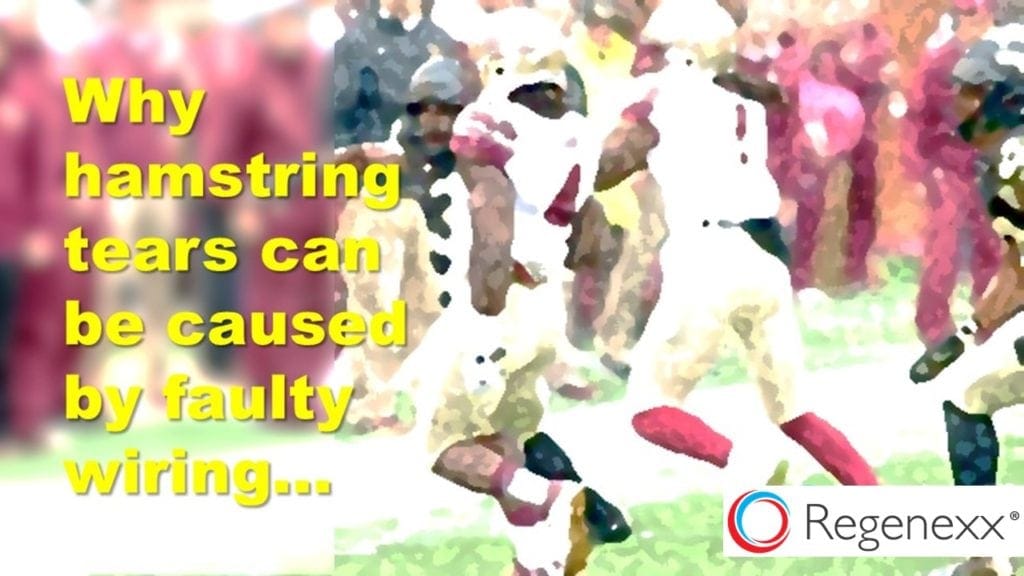Nagging Hamstring? Carpentry vs. “The Electrical”
I had the honor a while back of taking one of my sons to a college football rivalry game at my alma mater. It was a great game despite one of our star players suffering from a nagging hamstring problem (but he still broke 200 yards of rushing)! As I walked back to our hotel at midnight with my son, I thought about reaching out to the team surgeon to help. More importantly, I thought about how the innate differences between the surgical approach (carpentry) and the neurologic approach (wiring) in conceptualizing what’s wrong with this player’s hamstring might make that interaction challenging. Let me explain.
Our musculoskeletal systems are made up of bone, joints, ligaments, and muscles (the structural parts). However, all too often physicians also forget they’re made up of nerves (the wiring) that tell the muscles how to move the other parts. In fact, it’s even more complex than that because there are millions of tiny sensors in every muscle that feed information back along the wiring to the spinal cord and brain to fine tune movement. Orthopedic surgery, and hence much of modern sports medicine, is very focused on the structure and like medical carpentry, does a great job of cobbling the broken parts back together using increasingly sophisticated techniques. However, what happens when what’s causing the structural problem is likely due to the wiring? This is in essence a problem for the electrician, but when the carpenter is looking at the problem, it’s often missed.
The hamstring is a complex of muscles in the back of your thigh that bend your knee, pull the knee meniscus out of the way, and fine tune the rotation of your tibia leg bone on the femur thigh bone. Tears in the muscle as a result of sports are common and can end or nag an athlete’s entire career. Because of new technologies like platelet rich plasma and stem cell injections using precise imaging guidance (interventional orthopedics), the number of surgeries being performed for these problems is dramatically decreasing. However, many times there’s another dimension to the problem that’s missed. This is often a low level irritation of the spinal nerve (usually S1) that goes to the hamstring muscle and causes the tendon to degenerate because of lack of nutrients to the area as well as the inefficient contraction of the structure which causes it to yank on it’s attachments. In our clinical experience, identifying and treating this last part can make the difference between a successful and failed treatment. Again, in essence, understanding that the structure (carpentry) can be dictated by the complex wiring.
The trainers at my alma mater did a great job with this player’s hamstring injury. However, you could see that despite this athlete’s stellar performance, he wasn’t anywhere near 100% as he went out midway through the game so the trainers could work on him on the sidelines. Some of the things the trainers were doing were wiring related treatments like contract-relax holds. These exploit the feedback from the tiny sensors in the muscle tendons to tell the wiring to release the tight muscle. However, when a hamstring injury meets a carpenter’s mindset, the focus is all too often only on the structure of the muscle tear. The surgeon carpenter often ignores the electrical issues that may have caused and facilitated the injury. In this case, the irritated nerve in the low back (which may not be causing any low back pain per se) that needs to be treated. In the case of our injured player who has a tremendous NFL career ahead of him, taking a close look at the wiring is essential for his future. If these issues are found, what can be done? We’ve successfully treated many of these hamstrings tears without surgery by both precisely injecting PRP or stem cells into the tear and using the patient’s own growth factors injected around the irritated nerve in the low back.
The upshot? A hamstring muscle tear or any muscle or tendon tear always needs to be viewed as the whole machine, which includes the structure and the wiring. If a part in your car engine went bad, the first thing a modern mechanic does is to hook it up to the diagnostic systems that check the wiring and the many sensors and computers in the engine. If a problem is found, fixing the wiring is as important as fixing the part. However, what if your mechanic ignored the wiring? In many ways, that’s what happens in today’s modern orthopedic sports surgery world. For this young player or for any weekend warrior, a hamstring tear often has more to it than just the structural issue – it usually involves some faulty wiring that caused the tear in the first place!

If you have questions or comments about this blog post, please email us at [email protected]
NOTE: This blog post provides general information to help the reader better understand regenerative medicine, musculoskeletal health, and related subjects. All content provided in this blog, website, or any linked materials, including text, graphics, images, patient profiles, outcomes, and information, are not intended and should not be considered or used as a substitute for medical advice, diagnosis, or treatment. Please always consult with a professional and certified healthcare provider to discuss if a treatment is right for you.
